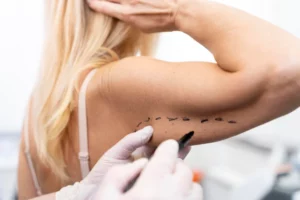Arm Lift Surgery – What is It?
An arm lift — with or without liposuction — can help your arms to firm their droopy or sagging apperance. This procedure can create a sculpted upper arm that complements your figure and your wardrobe. Today’s arm lift techniques are safer and the scars much less conspicuous than in the past.
Candidates for Arm Lift
Arm lift is one of the top four most popular plastic surgery procedures performed following massive weight loss. This is because people who have lost massive amounts of weight are often left with significant amounts of skin hanging under their arms.
The soft tissue of the arm becomes lax, setting the stage for ptosis. Thin people, too, may have sagging upper arms due to the effects of aging and genetics. Also people who exercise such as Pilates and strength training regularly cannot get rid of excess, sagging skin that develops in this area.
Before Your Arm Lift
It is better to follow some preoperative instructions before your arm lift procedure such as quitting smoking which can have deleterious effects on wound healing. And to stop taking certain medications such as aspirin, non-steroidal anti-inflammatory medications and certain vitamins and supplements that are known to increase bleeding risk.
Also another suggestion is to take certain supplements before your surgery to reduce swelling and bruising like arnica or bromelain. A high-protein diet may also enhance the healing process.

The Arm Lift Procedure
An arm lift typically takes one to three hours depending on the extent of the surgery. It may involve local anesthesia with intravenous sedation — leaving you awake, but not totally aware — or general anesthesia.
Liposuction alone may be sufficient for people with smooth skin and just a small amount of flab. The arm lift procedure may benefit people with larger areas of fat underneath the arms, poor skin quality and sun-damaged skin.
To perform an arm lift, our surgeon will make incisions on the inside or back of your arm. The incision pattern varies based on the extent of the surgery and our surgeon’s preferred method of treatment. Incisions typically span from the underarm to just above the elbow.
Some people may only require minimal incisions where the inner, upper arm joins the armpit. This is known as a minimal incision arm lift. You may be a candidate for a minimal incision arm lift if you have a small amount of extra skin located near the armpit.
Others, including people who have lost massive amounts of weight following bariatric surgery, may have more excess skin and need an incision that runs from the elbow to the arm pit and onto the side of the chest.
After the incision is made, excess fat may be removed with liposuction. Excessive skin is then trimmed, tightened and sutured in place with absorbable sutures or stitches that will be removed within one or two weeks of the surgery. At this stage your skin will be smooth over the new contour of your arm.
Recovering From Your Arm Lift
You should expect some swelling, bruising and mild discomfort after the procedure, but your arm should appear trim and toned almost immediately. Our surgeon can prescribe prescription pain medication to help alleviate this pain.
Swelling will peak two to three days after your arm lift, typically dissipating within two weeks. Elevating your arm with pillows can help reduce swelling and increase your comfort during recovery.
Dressings are typically applied to the incision. Many of the stitches will dissolve, but those that are not self-absorbing are usually removed within a week. Your surgeon may prescribe a compression garment to allow the skin to adhere to underlying tissues.
It’s OK to shower one week after the procedure, and most people can go back to work two to three weeks after the procedure. Our surgeon will likely tell you to avoid any strenuous exercise for one month, and to avoid heavy lifting for at least six weeks. Individual instructions vary.
Risks of Arm Lift
No surgery is risk free. Arm lift risks include:
Infection
Hematoma
Anesthesia risks
Loss of sensation
Scarring
Swelling of the hands
Seromas (fluid-filled masses along the incision line)
